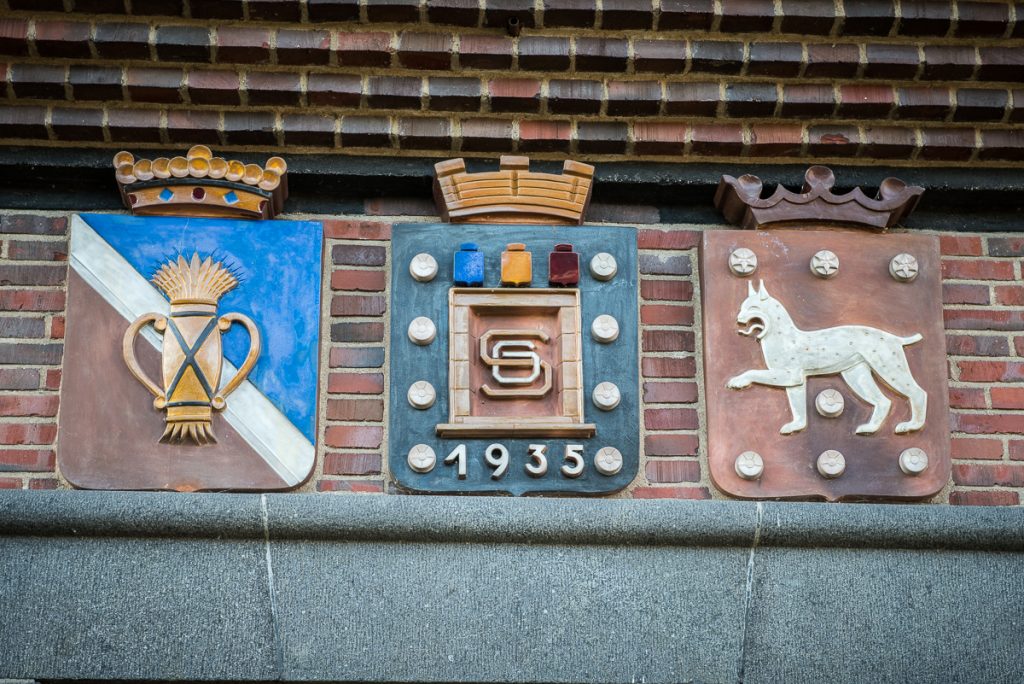In the autumn of 1935 Gösta Serlachius communicated eagerly with the company Kupittaan Savi Limited Company about the manufacture of coats of arms to decorate the entrance of Joenniemi Manor. Winter was closing in and the manufacture was running late. As a result, Serlachius started to get impatient.
Architect Jarl Eklund desined Joenniemi Manor, completed in 1935. The façade of the manor shows features of classicism. It reminds one of the castle of Louhisaari located in Askainen. In other words, the entrance of Joenniemi is a minimalist version of the sandstone portal of Louhisaari. Gösta Serlachius commissioned the Turku-based company of Kupittaan Savi Ltd. Company to make three coats of arms to this section.
The coats of arms at Joenniemi manor highlight the idea of home and homestead. Together they tell Gösta Serlachius’ life story – how he left his childhood home in Pietarsaari. Subsequently he put down his roots in Mänttä and build his life there. The early 20th century coat of arms of Finland’s province of Vaasa on the left hand side refers to the area where Gösta Serlachius was born. On the other hand, the coat or arms of Häme Province to the status quo of that time. It put Gösta Serlachius and his home on the Finnish map.
The theme of the third coat of arms in the middle is more personal. In his letters Gösta Serlachius refers to it as the monogram. It’s basis is on the initials that are in the middle of the coat of arms. However, its motif is a direct quotation of the façade of Joenniemi Manor. A frame depicting the entrance of Joenniemi Manor outlines the initials GS of Gösta Serlachius. The upper part of the coat of arms contains three tiny escutheons. On the other hand, the lower part the year 1935, which is the completion year of the manor. On the both sides there are four white rosettes whose meaning is as yet unknown.
Architect Elsi Borg has designed the coats of arms of the provinces of Vaasa and Häme. Whereas, Joenniemi’s main architect Jarl Eklund designed the monogram. He also oversaw the manufacture of the coats of arms. They were moulded of clay and fired and glazed at the Factory of Kupittaan Savi Limited Company located in Turku.
This was a difficult commission since they wanted to attach the coats of arms to the façade of the building. It has to stand all kinds of weather. In his letters, the director of Kupittaan Savi Ltd., Kaarlo T. H. Koponen expressed his concern. He was worried about how the colours of the coats of arms could endure the changing weather conditions. Furthermore he worried about how to prevent different colours of the different layers of the glaze spreading during the glaze firing.
Koponen suggested different kinds of solutions to the problem but Serlachius did not seem to have any interest in technical deliberations. He only wanted to have his coats of arms in Mänttä soon. Subsequently, the autumn was turning into winter. Therefore he was afraid that once the weather got cold, it would prevent the laying of the coats of arms on the wall.
A message from Turku came in November 1935. It informed that the coats of arms of the Provinces of Vaasa and Häme were ready and that the monogram was in the making. The letter ends with an account of the working phases planned and a suggestion that architect Eklund should travel to the factory to supervise the manufacture of the monogram. Serlachius refused. Eklund did not travel to Turku because it would have cost too much. Serlachius answered instead that he trusted the craftsmanship of the workers of the factory. He urged them to consult an architect in Turku if necessary.
Kupittaan Savi Limited Company’s letter dated on 14 December 1935 to Gösta Serlachius ends with a handwritten statement by Kaarlo T. H. Koponen, the manager of the factory: “The manufacture of the coats of arms has been successful so far. The items will soon be dry. Next week they will be put in the oven for the first firing. After that they will be glazed and receive glaze firing. They will be ready sometime at the beginning of the next year.
K.”
Suvi-Mari Eteläinen
Curator


